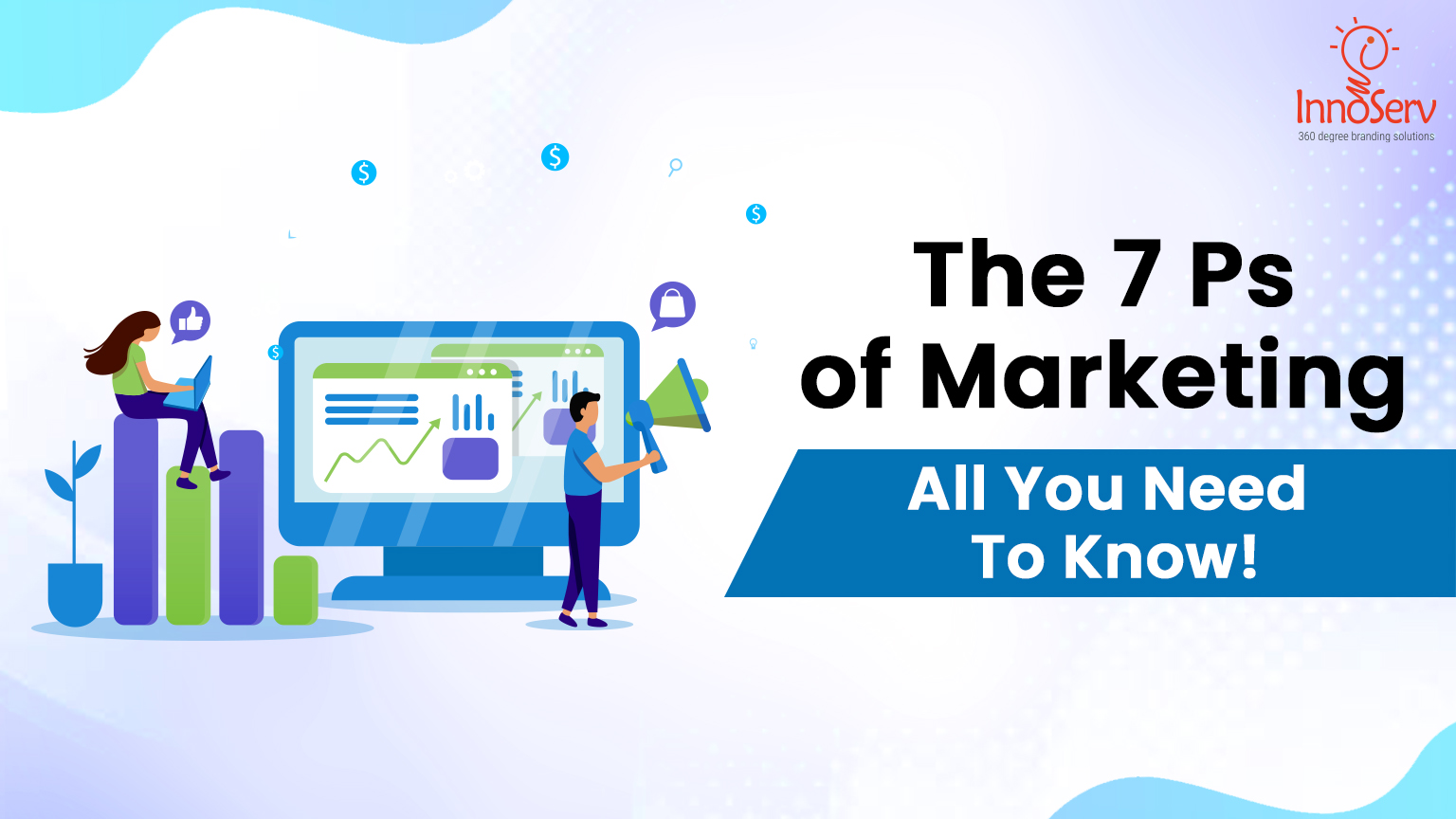The 7 Ps of Marketing: All You Need To Know!
Every effective marketing strategy includes the seven Ps of marketing mix. Any firm can construct their marketing strategy using these components in order to increase market share and protect the target market. In today's environment, consumer education is rising, and businesses are employing a variety of strategies to increase their market share. This emphasises the value of focusing on the 7Ps of the marketing mix because it helps to bring all the crucial elements of the good or service into focus.
What Is The Marketing Mix?
As a component of an all-encompassing marketing strategy, a marketing mix encompasses many areas of emphasis. Instead than focusing solely on one message, effective marketing touches on a variety of topics. This makes it easier to connect with more people, and by remembering the seven Ps, marketing professionals are better able to keep their attention on the things that are really important. When releasing new products or updating current ones, firms can make more strategic decisions by concentrating on the marketing mix.
What Are The 7Ps Of Marketing?
Over time, the marketing mix evolved into one of the key elements of the marketing strategy.
In this blog, we'll take a closer look at the 7Ps approach, as well as the value and practical use of this marketing mix.
The 7 Ps Of Marketing
1. Product
The item that the seller offers to satisfy a customer requirement is known as the product. The product may be physical or abstract. The product ought to be able to satisfy the customer's anticipated requirement. It ought to be made available on the market to close the gap between consumer expectations and supply.
2. Place
The consumer should be able to easily purchase the newly offered product. The product should be accessible to the target market anytime they desire to purchase it. The location may not always be a physical store. It could be an online store with delivery services, a business that uses social media, or a virtual store.
3. Price
When weighed against the benefits and quality of the product, the price should be considered fair. It does not imply that the item must be inexpensive. However, the price of the item shouldn't be excessive given its quality. The target market must have the financial means to buy the product.
4. Promotion
Promotion of the product is how the target market is introduced to the product and its benefits. Advertising, personal selling, social media selling, after-sale services, and sales promotions are all included. Promotion should be able to draw in potential buyers and reach the product's target market.
5. People
For the entire marketing process, it is crucial to have the right people including everyone who contribute to any part of the production process, from pre-production to post-sale services. People need to grasp both the product and the target market thoroughly. They ought to be able to successfully integrate the product into the target market and gain a larger market share.
6. Process
The path taken by the production technique or service from beginning to conclusion is known as the process. It is closely related to how much the product costs. The manufacturing process must be carried out such that clients receive the most value for their money when purchasing a good or service. Processes should be compliant with customer expectations, production standards, and quality standards. In addition, the procedures should help provide clients with a need that hasn't been satisfied.
7. Physical Evidence
The majority of the services offered in the present corporate sector are intangible. The customer should be assured that the service will meet their expectations before making a purchase. In order to guarantee this quality, marketers have developed "physical proof" that gives consumers cues. These signs will make it easier for customers to assess a service before paying for it.
Steps To Develop A Successful Marketing Mix
Make use of these 10 steps to help create the ideal marketing strategy for your successful product.
Step 1. Goals and Objectives
To establish the best marketing mix, you must first specify your desired outcome, such as increased revenue, brand exposure, or customer base. Every marketing strategy has unique marketing objectives. Make sure you've given yourself a deadline to reach your objectives.
Step 2. Establish Your Budget
Your marketing budget, which should be specifically mentioned for each channel you employ, is the sum of money you have set aside to cover all of your marketing costs. Even people who work in the marketing field find it challenging to establish a marketing budget. As a result, you must carefully consider and determine how much money you are willing to spend on user research, product innovation, and advertising campaigns.Setting a budget for your activities can enable you to manage your spending and distribute funds effectively.
Step 3. Determine Your Unique Selling Proposition (USP)
The USP, or unique selling proposition, should draw attention to the aspects of the product that can best serve the needs of the user. Ideally, you should think of 1-2 distinctive traits that set you apart from your competitors. Another strategy used by marketers to remind clients about their products is to market around the USP of the product.
Step 4. Who is Your Target Market?
You need to be aware of who your audience is and how to effectively reach them in order to communicate with them. Create a comprehensive profile of your target customer. Make sure you've acquired sufficient consumer information to create a thorough profile of your ideal customer.
Step 5. Ask Your Customers Advice
Take surveys to learn what your customers truly think about your brand to get the answers to the following:
What do consumers think of the service or product?
Are they content with your offering?
What unique advantages does your product offer the consumer?
Does the product suit the needs of the customer?
You must arrange the customer survey process in addition to the questions. When, where, the preferences of your target audience, and the expected outcomes. These are the issues with which a survey should be concerned. You can avoid being blindsided by unpleasant circumstances by having the proper customer feedback strategy.
Step 6. Define Your Product in Detail
Spend the time necessary to create a number of high materials that thoroughly define your goods or services. To accentuate the worth of your product, put an emphasis on its unique features.
Step 7. Know Your Distribution Channels
A crucial phase of the marketing mix plan is distribution. It creates the circulation that aids in getting the product to the consumer. The regulation for distribution middlemen will also have an impact on business earnings. You'll construct a distribution channel based on the following customizations, depending on your product group and target market, such as providing to distributors => retail stores => consumers, supplied straight to retailers, or offering directly to customers.
Step 8. Create a Pricing Strategy
To be able to offer competitive pricing and satisfy customers without overly depending on their psychology, research your competitors. Additionally, you need to consider the following aspects:
- Manufacturing procedure for goods.
- What category does your target market fall under?
- What they are prepared to spend.
Step 9. Choose Your Promotional Techniques
If the brand's marketing staff does not do a good job of promoting the product, a marketing mix campaign will not be successful. This crucial stage aids customers in becoming familiar with your brand's name and the goods you are selling. There are numerous ways to advertise, including:
- Advertising.
- Personal Selling
- Direct Marketing
- Public Relations (PR).
- Sales Promotion
- Word of Mouth
Step 10. Use Inbound Marketing
An ideal marketing mix campaign must be implemented while using the inward marketing technique known as inbound marketing.
Implementing Inbound Marketing successfully should include:
- Programming – Website design
- Writing blogs
- Search engine optimization (SEO)
- Social media
- Email marketing
Who Created The 7Ps Marketing Mix Model?
E. Jerome McCarthy created the 7Ps marketing model in the beginning, and he published it in 1960 in his book Basic Marketing ‘A Managerial Strategy’. When the importance of customer service in fostering brand growth wasn't as well understood, the 4Ps marketing mix indicated an early emphasis on product marketing.
Participants, Physical evidence, and Processes were added to the "service mix P's" in 1981 by Bernard H. Booms and Mary J. Bitner. The marketing mix’s "Participants" was later renamed to "People." Today, it's advised to analyse competing strategies taking into account all 7 components of the marketing mix. The 7Ps assist businesses in reviewing and defining important factors that have an impact on the marketing of their goods and services.
Importance Of 7P’s Marketing?
The key to moving your company in the right path is realising the value of marketing mix approaches. A few benefits of the marketing mix include:
- Provide data for resource allocation
- Solve distributed data problem
- Create trade promotion opportunities
- Helps optimise marketing budgets
- Helps establish effective insights on future trends and variables
How You Can Use 7Ps Marketing Model?
Once your marketing strategy has been created using the "Seven P Formula," you should continue to review and assess your business operations.
You must regularly review these seven Ps to ensure that you're on track and getting the best outcomes possible in the market today as products, markets, customers, and demands change quickly.
The 4Ps Vs. The 7Ps
The goal we aim to accomplish determines how the 4Ps and 7Ps differ. Businesses benefit from a broader grasp of how to satisfy the requirements and expectations of customers thanks to the extended marketing mix. The 4Ps model is a crucial tool, even though it is often considered out of date. Small enterprises who sell "standard" products find the model to be very helpful. The traditional definition of marketing mix in this instance is more consistent with the principles and goals of the internationalisation process.
The 7Ps model should be used if your company specialises in offering a service or a very distinctive product. Customer satisfaction in this scenario is influenced by the purchasing experience and the level of post-purchase assistance. The emergence of e-commerce and digital transformation have changed how consumers discover and buy things in many ways. Consumers today are more discerning and demanding in their selections rather than being passive. In this regard, the 7Ps model provides the appropriate framework, shifting from a company-centric to a consumer-centric approach.
7 Ps Of Marketing Example
The following examples of real-world marketing mix strategies centre on businesses that have selected one component of the marketing mix to leverage as a strategic advantage. By setting all of its prices at $1 or less, Dollar Tree makes use of price as a selling point. This strongly suggests to their target customer that they will save money if they shop at their establishments.
The product application is Tiffany & Co.'s competitive advantage. Only at their store can one purchase the "Tiffany True Cut," which is their distinctive diamond cut. Their packaging's "Tiffany Blue" is so distinctive that the Pantone Company even named the colour after the company.
Apple prioritises product innovation as the marketing mix quadrant they will employ to get a competitive edge. Apple stands out from the competition thanks to its innovative product designs, and its catchy advertising.
Top 12 Marketing Models
Marketing models can be overwhelming to many people. They are now one of the main factors that any marketer employs to plan and assess how customers and businesses will connect.
They make use of it since science and analytics are still vital to the success of marketing. In their most basic forms, all marketing models are a reflection of how internal and external elements affect a brand's capacity to reach its target markets at the most efficient costs.
- 1. 7 Ps Of Marketing
- 2. USP (Unique Selling Proposition)
- 3. Boston Consulting Group Matrix
- 4. Brand Positioning Map
- 5. Customer Lifetime Value Marketing Models
- 6. Growth Strategy Matrix
- 7. Loyalty Ladder Marketing Models
- 8. PESTLE (Asses Impact On Political, Economic, Social, Technological, Legal, And Economic Factors)
- 9. Porter’s Five Forces
- 10. Product Life Cycle
- 11. Segmentation, Targeting, And Positioning
- 12. PR Smith's SOSTAC (Situation, Objectives, Strategy, Tactics, Actions, Control) Model
The Bottom Line
You can create goods and services that better meet the demands and preferences of your target market with the use of a well-developed marketing mix. If your market mix is effective, it will communicate to your customers why your product or service is superior to that of your competitors. Although the 4Ps should be the foundation of your marketing mix, the other three Ps should be included in your overall marketing strategy.
More people are using the Internet as a result of its expansion. The number of individuals using the Internet worldwide is above 7.7 billion. Online searches, social media checks, and product purchases have all become everyday practices. One of the most efficient ways to reach the target audience is through digital marketing. It is a strategy that adheres to the definition because utilising various digital platforms to market to, engage with, and serve customers has a variety of advantages, including bringing in new clients and market segments, keeping customers engaged after the sale, gaining their trust and loyalty, increasing sales and customer satisfaction, and better understanding customer demand and needs.
At InnoServ Digital, we have a single, straightforward objective: Using our knowledge of the digital marketing industry and its potential to make sure that brands that pick us see sustained, exponential growth in their businesses. Simply put, we're committed to accelerating your ROI through our digital expertise. We have already employed our digital knowledge to revolutionise a number of brands and companies, so we can't help but be thrilled to write another success story with and for you.












